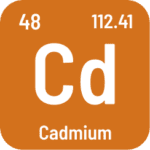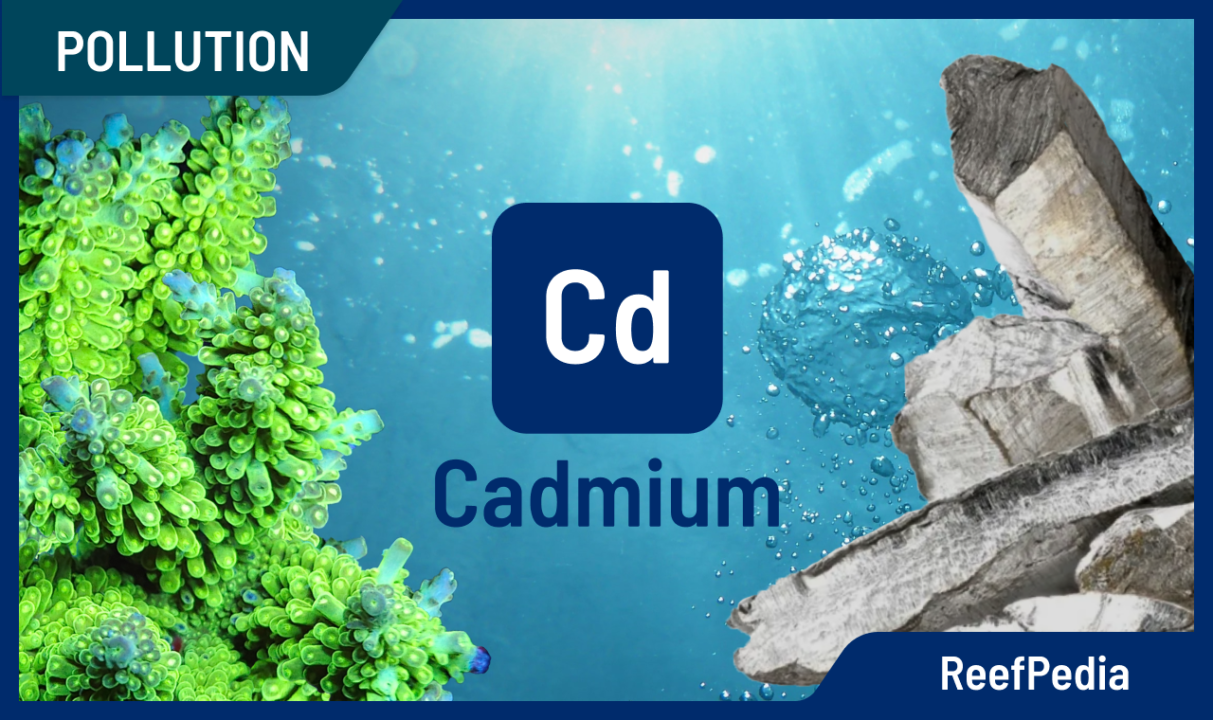Table of Contents
What is CADMIUM (Cd)?
 Cadmium (Cd) is a chemical element that belongs to the group of transition metals*. It is found in small amounts in the Earth’s crust in minerals such as greenockite (CdS) or monteponite (CdO). It belongs to the group of heavy metals and is often found alongside zinc oxide (ZnO) as an impurity.
Cadmium (Cd) is a chemical element that belongs to the group of transition metals*. It is found in small amounts in the Earth’s crust in minerals such as greenockite (CdS) or monteponite (CdO). It belongs to the group of heavy metals and is often found alongside zinc oxide (ZnO) as an impurity.
The importance of cadmium in seawater
Cadmium doesn’t play a significant role as a trace element in seawater; instead, it’s toxic to living organisms. Its presence in a reef tank should be considered pollution. Higher concentrations of cadmium, detectable by ICP-OES devices, are toxic to corals.
Cadmium toxicity is much higher in corals than in fish. Some coral species, like goniopora, are known to accumulate cadmium in their skeletons and tissues. However, this doesn’t mean that accumulating this element is safe for marine organisms; on the contrary. For instance, cadmium can displace zinc (Zn) or copper (Cu) from other compounds, disrupting the formation of crucial enzymes in the marine environment.
Dangers related to excess cadmium in seawater
No species of animals or algae sensitive to cadmium overdose are known. An excess of this trace element negatively affects most animals. Remember, the toxicity of metals and their impact on organisms, including marine ones, depends on many factors, including the organism’s ability to regulate their uptake. There are organisms known to have developed protective mechanisms against the toxic effects of some elements, such as chromium (Cr), copper (Cu), or zinc (Zn). However, in the case of cadmium (Cd), even small amounts in seawater are harmful to animals, indicating that organisms haven’t sufficiently evolved protective processes against this element.
High levels of cadmium can lead to health problems in corals and other animals, and even to their death. A cadmium concentration in seawater > 5 μg/L causes coral bleaching in species like montipora, seriatopora, or acropora.
How to protect your aquarium?
It’s important to regularly monitor the cadmium content and maintain it at an undetectable level – 0 μg/L. Such a level of cadmium in seawater ensures the health and vibrant coloration of marine animals.
The most accurate and reliable method for determining cadmium is through ICP-OES analysis. Inductively Coupled Plasma Optical Emission Spectrometry (ICP-OES) is the most precise analytical method for analyzing the elemental composition of seawater.
Recommendations
To maintain the proper level of cadmium in the aquarium, you should regularly test it. If the cadmium level remains high for an extended period, it can lead to health issues for corals and other animals, even causing their death. The most common reasons for exceeding the recommended cadmium level are:
- contaminated salt,
- artificial rocks,
- galvanized metals,
- frozen foods,
- tap water,
- osmosis system built with metal elements.
Find and eliminate the cause of the problem, then lower the value of this parameter in the water. Perform up to 6 water changes. It’s recommended to replace about 15% of the aquarium water during each change until the recommended value of this parameter is reached. The water prepared for replacement must have the appropriate target salinity level. Use salt with the correct parameters and composition suitable for conducting the ICP test.
Summary
An excess of cadmium (a heavy metal) in seawater poses a serious threat to most marine organisms because even small amounts can harm animals. Marine organisms haven’t developed adaptive defenses against the toxic effects of cadmium – corals die at concentrations > 5 μg/L. To protect marine animals in the aquarium from the negative effects of cadmium, it’s recommended to maintain its level at an undetectable value (0 μg/L), ensuring the health and vibrant coloration of the animals.
*Transition metals – a group of chemical elements in the periodic table, including the side groups of the periodic table, i.e., groups 3-12.
About author

Magdalena Metzler
Privately, I am a mother and a lover of nature and sport. My main interest is quantum chemistry, which hides a whole lot of unsolved mysteries and connections, which is extremely exciting from a scientific point of view.
In my scientific career, I have conducted international projects focused on innovative solutions for many branches of business, e.g. automotive, construction, and now, of course, marine aquaristics.
Working at Reef Factory gave me a passion for marine aquaristics, which I can develop every day, building a chemistry department and creating products that will help aquarists take care of tanks and ensure the highest safety of animals. One of the most exciting memories of working at Reef Factory is the commissioning of the ICP-OES spectrometer, which analyzes the elemental composition of seawater. The method of analysis in ICP is based on an analytical technique, which is a combination of my passion for quantum chemistry and marine aquaristics.
I hope you find my articles on ReefPedia interesting and helpful! Happy reading :))

